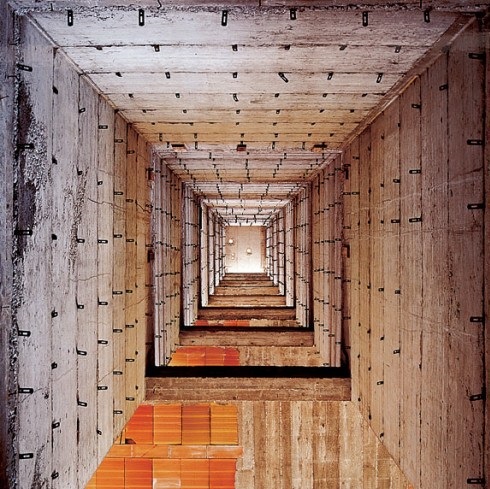
Anthony Hernandez
American, 1947-
Rome #17, 1999
inkjet print
36 × 36 in.
SBMA, Museum Purchase with funds provided by PhotoFutures
2015.13.1

Undated photo of Anthony Hernandez, SFMOMA
“The idea is that you have to find it—and you have to walk to discover what’s there.” - Anthony Hernandez
COMMENTS
Clearly, Pictures for Rome (1998–99) are not the same as pictures of Rome: Anthony Hernandez’s photographs make no reference to any of the many iconic landmarks of that ancient city. In fact, they make no reference to any city in particular, but focus instead on the discarded monuments of a generic consumerist metropolis, its modern ruins. In Hernandez’s photographs, the troubling architectural skeletons, debris of abandoned buildings, and languishing unfinished projects of modern society are considered as urban relics. Whether chronicling an aborted commercial building or never-completed hospital, an empty housing complex or deserted classroom, His images document the ghosts of urban renewal—the failed projects and material disasters that are the less glamorous side of urban development.
This social emphasis resonates with his earlier project Landscapes for the Homeless, a series made largely in his hometown of Los Angeles, where he photographed “homes” tucked under freeways or in the corners of abandoned lots. People are not to be found, but signs of their presence imbue every scene. The same is true of Pictures for Rome; for example, in Rome #1 graffiti marks two cobalt blue doors, and in Rome #25 the outlines of posters that once decorated the walls haunt the now-vacant room. This focus on the formal and poetic qualities of interiors sometimes results in photographs that are visually disorienting; for example, in Rome #17 what appears to be a series of receding rectangular concrete structures ending in ball-like objects suspended before a luminous glow is actually a view up an elevator shaft in an unfinished building. Hernandez’s emphasis on a structure’s formal allure invites us to enter the spaces in the photographs and imagine these unstable settings of abandon and dispossession. These modern-day Roman ruins are perhaps as enchanting as those of ancient Rome, but they are also disconcerting depictions of decay in our modern era of unprecedented material destruction and waste.
- Guggenheim Collection Online, © 2017 The Solomon R. Guggenheim Foundation
https://www.guggenheim.org/artwork/9430
SBMA CURATORIAL LABELS
Born and raised in Los Angeles and self-taught, Anthony Hernandez is one of the most accomplished artists using the large-scale color format today. For the past five decades, Hernandez has depicted contemporary urban landscapes and the people who live in them, often with an eye to investigating how geography plays a latent or overt part in socio-political issues. Like Dawoud Bey, Hernandez has worked in his own strain of street photography—one of his projects dealt with denizens of Rodeo Drive in the 1980s and the theater of conspicuous consumption they performed. Other series featured landscapes in Los Angeles’s nether areas, including largely unseen places homeless people dwelled; as well as LA’s public transportation system and the people who depended on this largely out-of-sight network in a city synonymous with freeways.
In his later career Hernandez has pictured works of architecture on their own, as seen in the three works displayed here, which nonetheless resonate with personal and social themes. In "Rome #17", a recurring geometric motif of an empty shaft in a building (taken when Hernandez, a Rome Prize winner, was in residence at the American Academy in Rome) presents an other-worldly scenario of ominous depth and distant light that resembles science fiction, but is in fact a kind of hidden structure that we use every day. In another, "Waiting in Line #20", a set of glass doors becomes an ambiguous barrier between an unknown interior space and an outside world of expectant transience in an image that refuses resolution. With such works as these, Hernandez, whose career was the subject of a 2016 retrospective organized by the San Francisco Museum of Modern Art, continues to pose probing questions about the nature and consequences of our contemporary built environments, and their imposition on both our land and our psyche.
- Crosscurrents, 2018
